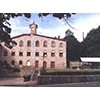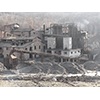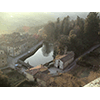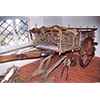Amiata

With its majestic, impervious profile that clearly betrays its volcanic origin, Mount Amiata towers unmistakable on the panorama of central-southern Tuscany. The economy of the populations that inhabit this territory was for centuries tied precisely to its peculiar geological nature. The extraction of mercury and cinnabar were flanked by a lively farming and shepherding activity that was founded on exploiting its vast forests.
The itinerary can begin at Abbadia San Salvatore, the main city of the territory, where the principal mining facilities were headquartered. In memory of this century-old industry, the Parco Museo Minerario collection offers a 360° panorama of Amiata mining civilisation.

Instituted in 2000, the Parco Museo Minerario is part of the Museum System of Siena. It is sited in the mining area of Abbadia San Salvatore where one of the world’s most important mercury mines operated, and where there are still mining plants and equipment, significant evidence of industrial archaeology.
The collection includes minerals, work tools, documents, objects and photographs on the extraction of mercury and on cinnabar, its derivative. The material is exhibited in the museum venue of Torre dell’Orologio, the first stage of a project that foresees the recovery of the entire mining area and the opening of both a documentary museum in the Mechanical Workshop, and of the Tunnel with the San Callisto shaft.
The institution conserves the archives of the "Monte Amiata" Mercury Extraction Society, of the Morone-Siele-Abetina-Solforate mines, of the "Monte Amiata" Hospital, of the Abbadia plants and the archive of drawings.
(Stefania Mangia)
Taking SP18 and continuing along SP6, after about twenty kilometres you come to Santa Fiora, whose destiny was for centuries tied to the mines. The local Museo delle Miniere offers an in-depth view not only of the prospecting techniques, but also of the social and sanitary aspects tied to this exhausting work.

The Museo delle Miniere of Santa Fiora is part of the Parco Minerario del Monte Amiata. Opened in 2002 in Palazzo Sforza Cesarini, it illustrates various aspects tied to the territory’s mercury mines, such as the techniques of prospecting and extraction, the tools used in the mines, the reconstruction of a tract of tunnel and the use of mercury in the course of time. It also presents aspects of a social nature, such as the health problems of workers and those tied to the mines closing.
(Graziano Magrini)
In the immediate vicinity, not far from the Oratory of the Madonna delle Nevi, the grandiose Renaissance fish-pool, a rare example of hydraulic engineering of the epoch, is well worth a brief visit.

Northeast of the little village of Santa Fiora, near the oratory of Madonna delle Nevi, a large basin (the "peschiera" or fishpond) collects the waters from the age-old springs of the Fiora River. Following a period of abandonment, the fishpond and park, which both date to the Renaissance period, were restored in 1851 by Lorenzo Sforza. The fishpond is surrounded by a wall of rusticated trachyte, and in the centre has two dolphins, their fins intertwined, and a trident. The park-museum adjoining the fishpond is home to many species of high-trunk trees (holm-oak, cypress, linden, chestnut, and magnolia).
(Graziano Magrini)
Leaving Santa Fiora and going southbound on SP160, we reach the locality of Santa Caterina, near Roccalbegna, which since the 1980s has been the headquarters of the Museo Etnografico that illustrates the many aspects of the traditional society of Amiata.

The Museo Etnografico Santa Caterina was inaugurated in November 1987 to document the daily life and the social and economic history of the Upper Valley of the Albegna and Mount Amiata. The collection (19th and 20th centuries) includes implements for weaving, spinning, gathering and processing chestnuts, harvesting grain, raising cattle, and pasturage. It also includes tools used by smiths, metal workers and charcoal-burners, various utensils and terracotta crockery.
(Stefania Mangia)
****************************
Texts by Elena Fani
English translation by Victor Beard
Last update 05/feb/2008



 = libraries and archives
= libraries and archives  = scientific research centers
= scientific research centers  = memorial places of scientists
= memorial places of scientists = public health places
= public health places = places of science and worship
= places of science and worship = places of technology
= places of technology  = museums and collections
= museums and collections  = villas and gardens of science
= villas and gardens of science

